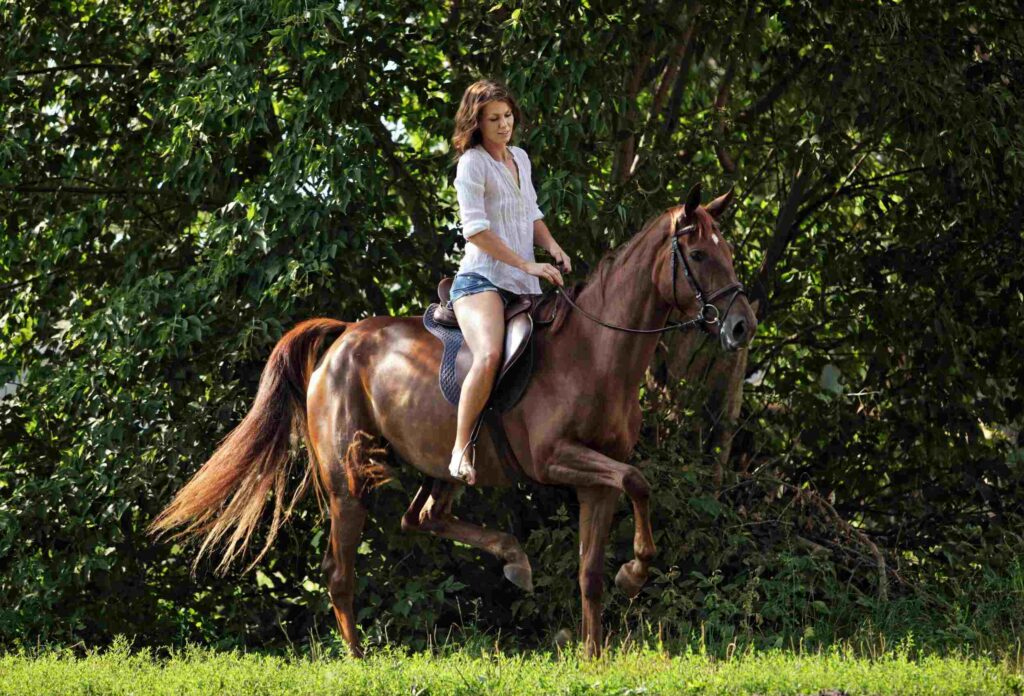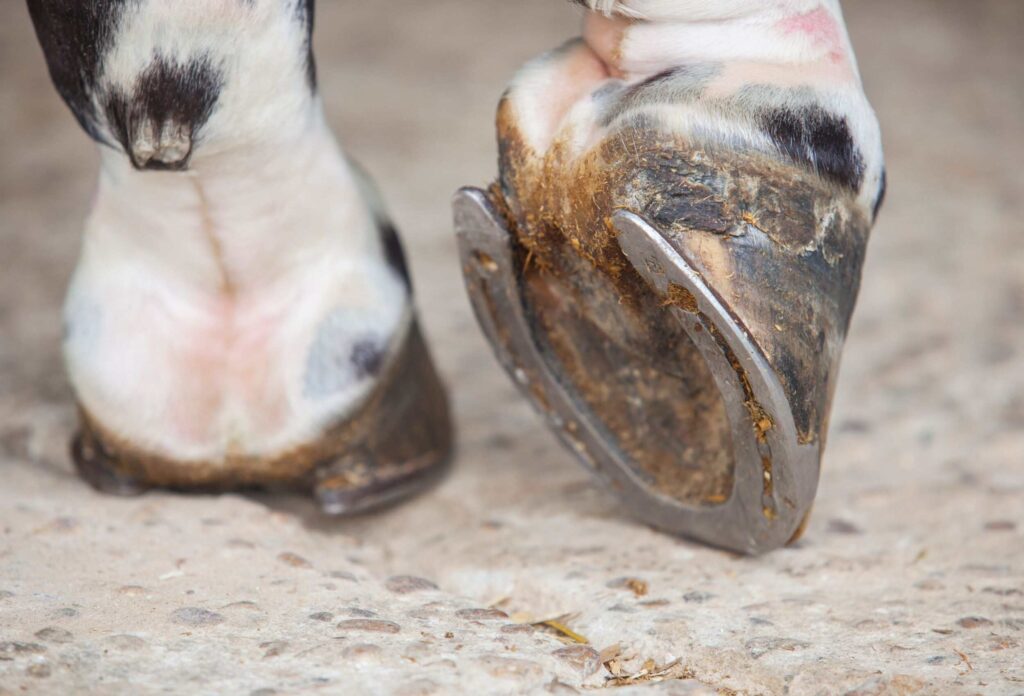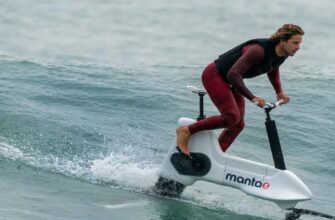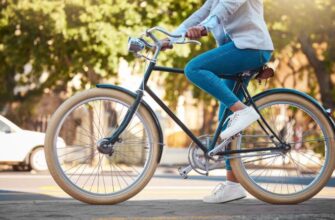Riding is a very exciting sport, but it has its limitations, to which we want to give a comprehensive answer in this article. We have made it in question-and-answer format for your comfort and have divided it into two categories.
Injuries and illnesses that may or may not allow you to participate in equestrian sport and injuries and illnesses of horses that may make it difficult or impossible to use them.
When You Can and When You Can’t Ride a Horse
Can you horse ride when pregnant?
No, riding a horse during pregnancy is not recommended. During pregnancy, there is a risk of loss of balance, falling, and abdominal damage that can be harmful to both the mother and the developing fetus.
Additionally, physical demands, such as holding the correct posture and controlling the horse, can be more difficult for pregnant women. For health and safety, it is recommended to avoid horseback riding during pregnancy.
Can you ride a horse after hip replacement?
After hip replacement surgery (hip arthroplasty), it is recommended that you contact your physician or surgeon for specific recommendations, as each case may be different.
Hip replacement surgery takes time to fully heal and regain strength and flexibility. Such surgeries are usually associated with restrictions on active physical activity, including horseback riding. In the initial period after surgery, it is usually advisable to avoid active activities that may affect the stability and functionality of the new joint.
Can you lose weight by horse riding?
Yes, horse riding can contribute to weight loss as it is a physical activity that engages various muscle groups and burns calories.
However, horse riding alone may not be sufficient for significant weight loss; it is most effective when combined with a balanced diet and regular exercise routine.
Can you go horse riding on your period?
Yes, it is generally safe to go horse riding while on your period.
Can you horse ride in shorts?

While it is possible to ride a horse in shorts, it is generally not recommended for safety and comfort reasons.
Wearing long pants, such as breeches or jodhpurs, is advisable as they protect your legs against rubbing, chafing, or potential friction from the saddle. Additionally, long pants can protect your legs from scratches, insect bites, or potential hazards you may encounter while riding.
Shorts do not provide the same level of protection and may expose your skin to potential irritations or injuries. For example, contact with the saddle, stirrup leathers, or horse coat can cause discomfort or skin abrasions.
Can I ride a horse on the road?
In many jurisdictions, it is legally permissible to ride a horse on the road.
How heavy can you be to ride a horse?
It is recommended that the rider’s weight, including their tack (saddle, bridle, etc.), should not exceed approximately 20% of the horse’s body weight. This guideline helps ensure that the horse can comfortably carry the rider without undue strain or risk of injury.
Can you ride a horse while drunk?
No, riding a horse while under the influence of alcohol is highly dangerous and strongly discouraged. Alcohol impairs judgment, coordination, reaction time, and overall cognitive function, all of which are crucial for safely controlling and riding a horse.
When intoxicated, your ability to communicate effectively with the horse, make quick decisions, and maintain your stability is significantly compromised. This poses a serious risk to your safety and the well-being of the horse.
Furthermore, impaired judgment and coordination increase the likelihood of accidents or falls, which can result in severe injuries for both the rider and the horse. Alcohol-related accidents while riding can also endanger others nearby.
What age can you ride a horse?
Children can begin taking introductory horseback riding lessons as early as 4 to 6 years old.
Can you ride horses on public footpaths?
In general, riding horses on public footpaths is not permitted. Riding horses on footpaths can pose safety risks to pedestrians and may also cause damage to the footpath itself.
Can you wear jeans for horse riding?
Yes, wearing jeans for horse riding is a common and suitable choice for many riders.
Can 2 people ride a horse?
Yes, two people can ride a horse together.
Double riding, or riding with two people on one horse, is typically done for short distances. However, it is important to note that not all horses are suitable or comfortable with carrying two riders.
If considering double riding, it is crucial to consider the following:
- Horse suitability: Some larger or stronger horse breeds may be more suitable for double riding.
- Rider weight and balance: The combined weight of both riders should not exceed the horse’s weight-bearing capacity. Additionally, it’s important to distribute the weight evenly and maintain proper balance to prevent discomfort or strain on the horse’s back.
- Tack and equipment: The horse’s tack, such as the saddle and girth, should be appropriate for accommodating two riders.
Can you ride a shire horse?

Yes, Shire horses can be ridden. Shire horses are a draft horse breed known for their strength, size, and gentle temperament. While they are primarily bred for pulling heavy loads or working in harnesses, they can also be ridden for various purposes, including pleasure riding, trail riding, or even certain equestrian disciplines.
Can you ride a horse in central park?
No, horse riding is not allowed in Central Park in New York City.
However, Central Park does offer horse-drawn carriage rides, which are a popular attraction.
Can you ride horses in the rain?
Yes, it is possible to ride horses in the rain.
Can you ride a horse if you weigh 300 pounds (136 kg)?
The ability to ride a horse when weighing 300 pounds depends on several factors, including the horse’s size, build, and physical capability to comfortably carry the weight.
For a rider weighing 300 pounds, it is important to choose a horse that is well-suited for carrying heavier weights. Consider larger horse breeds or draft breeds.
Can you wear leggings for horse riding?
Yes, you can wear leggings for horse riding. Leggings can provide a comfortable and flexible option for riding, particularly for activities such as casual riding, trail riding, or light exercise.
How soon can you ride a horse after giving birth?
The time frame for resuming riding lessons after childbirth can vary depending on several factors, including the person’s overall health, type of delivery, any complications during childbirth, and the recommendations of your health care provider.
In general, this period lasts from a few weeks to a few months, depending on the individual.
Can a blind person ride a horse?
Yes, blind individuals can participate in horse riding activities with proper training, support, and appropriate accommodations.
Here are a few considerations for blind individuals interested in horse riding:
- Specialized Training: Blind riders need to receive specialized training from experienced instructors who have expertise in working with individuals with visual impairments.
- Trustworthy Horses: Selecting a well-trained and reliable horse is crucial for blind riders. Horses with a calm temperament and a solid foundation in basic training can provide a safe and enjoyable riding experience. These horses can respond well to verbal and tactile cues, enhancing communication with the rider.
- Riding Aids and Support: Various aids and adaptations can assist blind riders in their equestrian pursuits. These can include verbal cues from the instructor or guide, tactile signals, and the use of specialized equipment such as reins with tactile markers or saddle handles for balance and stability.
- Riding Environment: Creating a safe riding environment is essential. Clear and consistent communication with the rider is important, and the riding area should be free of hazards or obstacles that could pose risks to both the rider and the horse.
Can you ride a blind horse?
Riding a blind horse can be possible in certain situations, but it requires careful consideration, appropriate training, and additional safety measures.
Here are a few important factors to consider when determining whether it is appropriate to ride a blind horse:
- Cause and Degree of Blindness: The cause and degree of blindness in the horse can greatly influence its suitability for riding. Horses that have been blind from birth or have gradually adapted to their blindness may be more capable of navigating and adjusting to their environment. Horses that have recently become blind or have limited spatial awareness may not be suitable for riding.
- Training and Familiarity: A blind horse should have received extensive training to respond to verbal and tactile cues, as well as have a deep familiarity with its surroundings and the riding environment. This training helps the horse navigate obstacles and maintain its balance and confidence while being ridden.
- Trust and Communication: Building a strong bond of trust and clear communication between the rider and the blind horse is crucial. The rider must be skilled at providing consistent cues and maintaining a calm and supportive environment to help the horse feel safe and secure.
- Safety Considerations: Riding a blind horse requires additional safety measures to minimize risks. This can include riding in familiar areas, avoiding hazards, using protective gear such as bell boots, and using vocal cues or specialized tack to aid communication.
Can you ride a horse without a bridle?
Yes, it is possible to ride a horse without a bridle, but it requires advanced horsemanship skills.
Can you horse ride with scoliosis?
Horse riding with scoliosis is possible in many cases, but it depends on the severity and specific needs of the individual with scoliosis.
Can you ride a 30-year-old horse?
Age alone does not determine a horse’s ability to be ridden, as some horses in their 30s may still be suitable for light riding activities, while others may have limitations due to age-related issues.
Can you ride a horse on Shabbat?
Riding a horse can be seen as an activity that involves exertion, potentially causing discomfort or stress to the animal, and it may be considered a violation of the spirit of Shabbat.
Can you ride a wild horse?
Riding a wild horse, also known as a feral horse, is generally not recommended, and it can be highly dangerous. Wild horses are not accustomed to human contact or handling, and they typically have minimal or no training.
Can you ride a horse with a heart murmur?
Riding a horse with a heart murmur should only be done under the guidance and approval of a healthcare professional, such as a physician or cardiologist.
The presence of a heart murmur alone does not necessarily preclude riding. However, if the individual experiences symptoms such as chest pain, shortness of breath, dizziness, or palpitations during physical activity, riding may need to be restricted or modified.
Can you ride a horse with a prosthetic leg?

Riding a horse with a prosthetic leg is possible, and many individuals with prosthetic limbs engage in horse riding activities.
However, it is important to consider a few factors when determining the feasibility and safety of riding with a prosthetic leg:
- Prosthetic Fit and Stability: The prosthetic leg should fit properly and provide stability and support during riding. It should be securely attached and designed to withstand the forces and movements associated with horse riding activities.
- Rider’s Experience and Comfort: Individuals with a prosthetic leg should have sufficient experience and comfort in wearing and using their prosthetic device. This includes having good balance, strength, and control over the prosthetic limb.
- Riding Technique and Adaptations: Depending on the type and level of amputation, riding techniques, and adaptations may be necessary. Adjustments in stirrup length, position, or additional support aids can be used to accommodate the prosthetic leg and enhance stability and control.
Can you ride a horse with a torn meniscus?
Riding a horse with a torn meniscus should be approached with caution and under the guidance of a healthcare professional, such as an orthopedic specialist or a sports medicine physician.
A torn meniscus is a common knee injury that can cause pain, instability, and limited range of motion.
Riding a horse with a torn meniscus carries the risk of further aggravating the injury, worsening symptoms, or causing additional damage to the knee joint.
Can you ride a horse with narcolepsy?
Riding a horse with narcolepsy is generally not recommended, as narcolepsy is a neurological disorder characterized by excessive daytime sleepiness and sudden, uncontrollable episodes of falling asleep.
Can you ride a horse in a dress?
Yes, you can ride a horse while wearing a dress. However, there are a few considerations to keep in mind for comfort, safety, and practicality:
Choose a dress that is an appropriate length and fit for riding. A dress that is too long or loose may get caught or tangled in the saddle or stirrups, creating a safety hazard.
Opt for a dress that allows for freedom of movement and does not restrict your legs or impede your ability to control the horse.
How many years can you ride a horse?
Horses have varying lifespans, with average ranges depending on factors such as breed, size, and care. Generally, horses can live anywhere from 20 to 30 years or more, with some horses even surpassing the age of 30. With proper care, nutrition, and veterinary attention, horses can remain active and ridden well into their senior years.
Can you ride a horse with a hernia?
Riding a horse with a hernia is generally not recommended without consulting with a healthcare professional, specifically a physician or surgeon who can evaluate the specific hernia and provide appropriate guidance.
Riding a horse can involve movements, jolts, and forces that may strain or exacerbate a hernia. Depending on the type and location of the hernia, riding activities could potentially increase the risk of complications, such as increased pain, discomfort, or potential for hernia incarceration or strangulation.
Can you ride horses in the snow?
Yes, it is possible to ride horses in the snow.
Horse Injuries and Illnesses: Conditions That Affect Riding Ability
How long can you ride a horse in a day?
It is generally recommended not to exceed 4-6 hours of active riding per day to maintain the horse’s health and well-being.
Can you ride a horse with Cushing’s disease?
Yes, in some cases, individuals with Cushing’s disease can continue riding horses, but it is essential to consider certain factors.
Cushing’s disease, also known as pituitary pars intermedia dysfunction (PPID), is a hormonal disorder that affects horses, typically in their middle to senior years.
The ability to ride a horse with Cushing’s disease depends on the severity of the condition and the symptoms exhibited by the horse. Horses with well-managed Cushing’s disease may still be physically capable of being ridden. However, it is crucial to consult with a veterinarian who can evaluate the horse’s overall health and provide specific recommendations.
Some common symptoms of Cushing’s disease in horses include excessive hair growth, weight loss or weight gain, increased thirst and urination, muscle loss, and lethargy. These symptoms can affect the horse’s comfort and ability to perform, so it is important to monitor their condition closely and make appropriate adjustments to their exercise regimen if needed.
How long after feeding can you ride a horse?
A common guideline is to wait at least 30 minutes to one hour after a horse has finished eating before engaging in any strenuous exercise or riding.
Allowing time for digestion is important because when a horse eats, blood is redirected to the digestive system to aid in the digestion process.
Engaging in vigorous activity immediately after feeding can interfere with the digestion and circulation processes, potentially leading to discomfort, colic, or other digestive issues.
Can you ride a horse after worming?
Yes, in most cases, it is generally safe to ride a horse after worming. Worming, or deworming, is a routine veterinary procedure aimed at controlling internal parasites in horses.
The timing of riding after worming depends on the specific deworming product used.
In general, waiting for a short period, such as 15 to 30 minutes, after administering the dewormer before riding is often recommended. This allows the horse time to swallow and properly absorb the medication.
Can you ride a horse after vaccinations?
It is typically safe to ride a horse after vaccinations. The administration of vaccines does not usually impose any immediate restrictions on riding or exercise.
How fast can a horse ride?
The speed at which a horse can ride varies depending on several factors, including the horse’s breed, conformation, fitness level, training, and the terrain on which it is riding.
In general, horses can achieve various speeds, including:
| Type | Speed |
|---|---|
| Walk | The walk is the slowest natural gait of a horse, typically ranging from around 4 to 6 miles per hour (6.4 to 9.7 kilometers per hour). |
| Trot | The trot is a two-beat gait that is faster than the walk. Horses can trot at speeds ranging from about 8 to 12 miles per hour (12.9 to 19.3 kilometers per hour). |
| Canter/Gallop | he canter is a three-beat gait, and the gallop is a four-beat gait. These are the faster gaits of a horse. The speed of a canter or gallop can vary depending on the horse, but it can typically range from around 10 to 30 miles per hour (16 to 48 kilometers per hour). Some horse breeds, such as Thoroughbreds or Arabians, are known for their speed and can reach higher speeds within this range. |
Can you ride a miniature horse?
Yes, it is possible to ride a miniature horse, but there are some important considerations to keep in mind.
Miniature horses are much smaller in size compared to full-sized horses, typically measuring less than 38 inches (96 cm) in height at the withers.
Riding a miniature horse is generally more suitable for small children or individuals of very lightweight.
Furthermore, miniature horses have different conformation and physical capabilities compared to larger breeds, and their back and skeletal structures may not be designed to support the weight of an adult rider.
Can you ride a horse with a kissing spine?
Riding a horse with a kissing spine (also known as impinging spinous processes or overriding dorsal spinous processes) is a condition where the vertebrae in a horse’s spine are abnormally close together, potentially causing pain and discomfort.
The ability to ride a horse with a kissing spine depends on the severity of the condition. Mild cases of kissing the spine may be manageable with appropriate management of some horses to continue light-riding activities.
However, in more severe cases, riding can exacerbate the horse’s discomfort and potentially worsen the condition.
Can you ride a horse with a navicular?
Navicular syndrome, also known as navicular disease, is a condition that affects the navicular bone and associated structures in a horse’s hoof. It can cause chronic lameness and discomfort.
In cases of mild or well-managed navicular syndrome, some horses may be able to continue with light riding activities.
Riding a horse with navicular syndrome should be done cautiously and under the guidance of a veterinarian or an equine professional experienced in managing horses with this condition.
Can you ride a horse with a swayback?
Riding a horse with a swayback (also known as lordosis or a dipped back) is a condition where the spine of the horse exhibits a concave or sagging appearance along the back.
In some mild cases, horses with swayback may be able to continue with light riding activities, provided that the horse’s back is properly supported and that the rider’s weight is distributed appropriately.
However, in more severe cases, riding can exacerbate the horse’s discomfort and potentially worsen the condition.
Can you ride a horse with a loose shoe?

Riding a horse with a loose shoe is generally not recommended. Loose shoes can be potentially dangerous for both the horse and the rider.
Here are a few reasons why:
- Comfort and Soundness: A loose shoe can cause discomfort or pain for the horse, as it may create pressure or movement against the hoof. This can affect the horse’s gait, balance, and overall soundness, potentially leading to lameness or injury.
- Stability and Traction: A loose shoe can compromise the horse’s stability and traction. It may affect the horse’s ability to grip the ground properly, increasing the risk of slips, trips, or falls, especially during riding activities that involve turning, jumping, or uneven terrain.
- Hoof Damage: If a shoe is loose, it can potentially cause damage to the hoof or surrounding structures. It may lead to chipping, cracking, or excessive wear of the hoof wall. Riding with a loose shoe can exacerbate these issues and potentially result in more significant hoof problems.
Can you ride a horse with cracked hooves?

Riding a horse with cracked hooves is generally not recommended. Cracked hooves can indicate underlying issues with the horse’s hoof health and can lead to discomfort, pain, or further damage. Here are some reasons why it is advisable to address hoof cracks before riding:
- Hoof Integrity: Cracked hooves can compromise the structural integrity of the hoof. Riding with cracked hooves can exacerbate the cracks, potentially leading to further splitting, chipping, or even more significant hoof problems. It is important to address the underlying causes of the cracks and provide appropriate hoof care.
- Comfort and Soundness: Cracked hooves can cause discomfort or pain for the horse, particularly if the crack extends into sensitive structures. Riding with cracked hooves can exacerbate this discomfort, and affect the horse’s gait, balance, and overall soundness, potentially leading to lameness or injury.
- Risk of Further Damage: Riding activities can subject the hooves to additional stress, impact, or strain. If the hooves are already compromised with cracks, it increases the risk of further damage, including the possibility of the crack worsening, deepening, or extending.
Can you ride a horse with mud fever?
Riding a horse with mud fever, also known as pastern dermatitis or scratches, can be uncomfortable and potentially worsen the condition. Mud fever is an inflammatory skin condition that primarily affects the lower limbs of horses, typically the pasterns and heels. It is caused by bacteria or fungi thriving in moist, muddy environments.
Here are some reasons why riding a horse with mud fever is generally not recommended:
- Discomfort and Pain: Mud fever can cause irritation, swelling, and soreness in the affected areas. Riding can exacerbate these symptoms, leading to increased discomfort and potential pain for the horse.
- Increased Infection Risk: The compromised skin associated with mud fever is more susceptible to further infection. Riding can introduce additional dirt, debris, or irritants into the affected area, increasing the risk of infection or worsening the existing condition.
- Aggravating Healing Process: Riding can impede the healing process of mud fever, as it can cause further trauma or damage to the affected skin. This can delay the resolution of the condition and potentially result in prolonged or more severe symptoms.
Can you ride a pregnant horse?
Riding a pregnant horse is generally not recommended, especially as the pregnancy progresses. There are several reasons for this:
- Risk to the Foal: Riding a pregnant mare can pose risks to the developing foal. The physical exertion, jarring movements, and potential falls associated with riding can increase the risk of injury or complications to the unborn foal.
- Stress and Discomfort: Pregnancy is a sensitive time for the mare, and riding can cause stress, discomfort, and potential hormonal imbalances. It is important to provide a calm and stress-free environment for the pregnant mare to support her well-being and the health of the foal.
- Balance and Coordination: As the pregnancy progresses, the mare’s balance and coordination may be affected, making riding more challenging and potentially unsafe for both the mare and the rider.
- Liability and Insurance: Riding a pregnant horse may also raise liability and insurance concerns. Many equestrian insurance policies have specific restrictions or exclusions regarding riding pregnant mares.
Can you ride a horse with white-line disease?
Riding a horse with white line disease is generally not recommended, especially during the active treatment and recovery phases. White line disease is a hoof condition that involves the separation and deterioration of the inner layers of the hoof wall, typically caused by a bacterial or fungal infection.
Here are a few reasons why riding a horse with the white-line disease is discouraged:
- Hoof Stability: White line disease weakens the structural integrity of the hoof wall, which can compromise the hoof’s stability and strength. Riding can subject the hooves to additional stress, potentially worsening the condition or leading to further separation and damage.
- Risk of Injury: The compromised hoof structure associated with white line disease can increase the risk of injuries, such as hoof wall collapse, lameness, or abscess formation. Riding can further aggravate these risks, potentially causing discomfort or pain to the horse.
- Treatment and Healing: White line disease requires appropriate treatment and management protocols to address the underlying infection and promote hoof healing. Riding can disrupt the treatment process, hinder the healing progress, and potentially contribute to the spread of infection.
Can you ride a horse with EMP?
Riding a horse with Equine Protozoal Myeloencephalitis (EPM) is generally not recommended, particularly during the active stages of the disease. EPM is a neurological condition caused by a protozoal infection that affects the central nervous system of horses. It can lead to a range of symptoms, including weakness, incoordination, muscle atrophy, and changes in behavior.
Here are a few reasons why riding a horse with EPM is discouraged:
- Safety Concerns: EPM can cause neurological deficits that affect the horse’s coordination, balance, and overall ability to perform physical tasks. Riding a horse with compromised coordination and muscle control can be unsafe for both the rider and the horse, increasing the risk of accidents or injuries.
- Exacerbation of Symptoms: Riding can place additional stress on the horse’s body, potentially exacerbating the symptoms of EPM. Physical activity may intensify weakness, incoordination, or other neurological signs, hindering the horse’s ability to perform and potentially prolonging the recovery process.
- Treatment and Rest: EPM requires appropriate treatment, often including medications to combat the protozoal infection and supportive care to aid the horse’s recovery. During treatment, it is generally recommended to provide the horse with rest and a controlled environment to optimize healing. Riding can disrupt the treatment process and impede the horse’s recovery.
Can you ride a horse with a dipped back?

Riding a horse with a dipped back, also known as swayback or lordosis, can be challenging and may not be recommended in most cases. A dipped back is a condition where the spine of the horse exhibits a concave or sagging appearance along the back.
Here are a few reasons why riding a horse with a dipped back is discouraged:
- Comfort and Soundness: A dipped back can cause discomfort or pain for the horse, as it may create pressure or movement against the spine and surrounding structures. Riding can exacerbate these issues and potentially lead to further discomfort, soreness, or lameness.
- Balance and Weight Distribution: The imbalance and altered structure of a dipped back can affect the horse’s balance, stability, and weight distribution. This can impact the horse’s ability to carry a rider and maintain proper movement and posture while being ridden.
- Potential for Injury: The compromised structure and stability of a dipped back can increase the risk of injury during riding, particularly if the horse is subjected to high-impact activities or uneven terrain. The added stress and strain on the back can potentially worsen the condition and result in further damage or pain.
Can you ride a horse with Lyme disease?
Riding a horse with Lyme disease can vary depending on the severity of the disease and the symptoms experienced by the horse. Lyme disease is caused by the bacteria Borrelia burgdorferi and can affect various body systems, including joints, muscles, and the nervous system.
Here are some factors to consider regarding riding a horse with Lyme disease:
- Veterinary Guidance: It is crucial to consult with a veterinarian experienced in treating Lyme disease in horses. The veterinarian can assess the horse’s condition, determine the severity of the disease, and provide appropriate treatment and management protocols.
- Symptom Management: Lyme disease can cause symptoms such as joint pain, lameness, muscle stiffness, fatigue, and neurological issues. Depending on the severity of these symptoms, riding may not be recommended or should be limited to activities that do not exacerbate the horse’s discomfort or strain its affected body systems.
- Rest and Recovery: Horses with Lyme disease may require a period of rest and recovery to allow the body to heal and respond to treatment. During this time, riding activities may need to be temporarily suspended to avoid further stress or exacerbation of symptoms.
- Monitoring and Adjusting Activities: As the horse’s condition improves, activities can gradually be reintroduced based on the guidance of the veterinarian. It is important to monitor the horse closely during and after riding sessions to assess its response and adjust activities accordingly.
Can you ride a roach back horse?
Riding a horse with a roach back can be challenging and may not be recommended in most cases. A roach back is a condition where the spine of the horse has an abnormal upward curvature along the back, creating a convex or humped appearance.
Here are a few reasons why riding a horse with a roach back is generally discouraged:
- Comfort and Soundness: A roach’s back can cause discomfort or pain for the horse, as it may create pressure or movement against the spine and surrounding structures. Riding can exacerbate these issues and potentially lead to further discomfort, soreness, or lameness.
- Balance and Weight Distribution: The altered structure of a roach back can affect the horse’s balance, stability, and weight distribution. This can impact the horse’s ability to carry a rider and maintain proper movement and posture while being ridden.
- Potential for Injury: The compromised structure and stability of a roach’s back can increase the risk of injury during riding, particularly if the horse is subjected to high-impact activities or uneven terrain. The added stress and strain on the back can potentially worsen the condition and result in further damage or pain.
Can you ride a horse with COPD?
Riding a horse with Chronic Obstructive Pulmonary Disease (COPD), also known as Equine Asthma or Heaves, can be challenging and may not be recommended in most cases. COPD is a respiratory condition that affects the airways of horses, causing inflammation, mucus production, and difficulty breathing.
Here are a few reasons why riding a horse with COPD is discouraged:
- Respiratory Stress: COPD can cause reduced lung capacity, coughing, wheezing, and difficulty breathing. Riding activities can increase respiratory demand, potentially exacerbating the horse’s symptoms and causing discomfort or distress.
- Environmental Triggers: Horses with COPD are often sensitive to environmental factors such as dust, pollen, and poor air quality. Riding in environments that contain these triggers, such as dusty areas or areas with high allergen levels, can worsen the horse’s respiratory condition and trigger symptoms.
- Exercise Limitations: Horses with COPD may have reduced exercise tolerance due to breathing difficulties. Riding can strain the respiratory system and contribute to fatigue, further compromising the horse’s well-being and performance.
- Medication and Management: COPD typically requires a comprehensive management plan, including medication, environmental modifications, and lifestyle adjustments. Riding activities may interfere with the prescribed treatment protocols and hinder the horse’s response to therapy.
Can you ride a horse with liver disease?
Riding a horse with liver disease should be approached with caution and in consultation with a veterinarian.
Liver disease in horses can manifest in various forms, such as hepatitis, liver failure, or liver damage. The symptoms can include jaundice, weight loss, lethargy, poor appetite, and compromised metabolic functions. We insist that you do not use the horse during a moderate or severe illness
Here are a few factors to consider when determining whether riding is appropriate for a horse with liver disease:
- The severity of the Disease: The severity and progression of liver disease can vary, ranging from mild to severe. Severe cases may significantly compromise the horse’s overall health, energy levels, and ability to engage in physical activity, including riding.
- Energy Levels and Exercise Tolerance: Liver disease can lead to decreased energy levels and exercise intolerance in horses. Riding can potentially exacerbate fatigue, stress the compromised liver, and worsen the horse’s condition.
- Medications and Management: Horses with liver disease may require specific medications, dietary adjustments, and management protocols to support their liver function and overall health. Riding activities should be considered in conjunction with these treatment plans and under the guidance of a veterinarian.
- Potential Complications: Liver disease can have systemic effects on the horse’s body, including impaired blood clotting, metabolic imbalances, and weakened immune function. These complications can increase the risk of injuries, exacerbate symptoms, or interfere with the horse’s ability to recover.
Can you ride a horse with arthritis?

The ability to ride a horse with arthritis depends on the severity of the condition, the specific joints affected, and the horse’s overall comfort and soundness.
Arthritis is a degenerative joint disease that causes inflammation, pain, and stiffness in the joints. It can affect a horse’s mobility, flexibility, and overall performance.
Here are a few factors to consider when determining whether riding is appropriate for a horse with arthritis:
- Severity and Location of Arthritis: The severity of arthritis can vary, ranging from mild discomfort to more advanced joint degeneration. The specific joints affected and the degree of inflammation and pain will impact the horse’s ability to perform under saddle.
- Veterinary Evaluation: A thorough veterinary evaluation is crucial to assess the horse’s arthritis and overall soundness. The veterinarian can provide specific recommendations regarding exercise, management, and the suitability of riding activities based on the individual horse’s condition.
- Rider Considerations: It is important to consider the rider’s weight, balance, and riding skills when determining whether riding is appropriate for a horse with arthritis. Some riders may be able to make accommodations and ride in a manner that minimizes stress on the affected joints.
Can you ride a horse without shoes?
Yes, it is possible to ride a horse without shoes, and there are certain circumstances where horses may be ridden barefoot. However, whether a horse can be ridden without shoes depends on several factors:
- Hoof Health: The hooves of a horse must be healthy, strong, and well-maintained to support the horse’s weight and handle the impact of riding without shoes. The hooves should be regularly trimmed and monitored by a knowledgeable farrier or hoof care professional.
- Terrain and Riding Conditions: The type of terrain and riding conditions should be considered. Riding on soft, even surfaces, such as sand arenas or grassy fields, may be more suitable for barefoot riding. Rough or abrasive surfaces, rocky terrain, or hard-packed trails may require protective hoof protection.
- Horse’s Comfort and Soundness: Some horses may have more sensitive hooves or specific hoof conditions that require protective shoes for riding. Horses with certain hoof abnormalities, such as thin soles, flat feet, or hoof diseases, may benefit from appropriate shoeing.
- Riding Intensity and Frequency: The intensity and frequency of riding also play a role. Horses engaged in intense work, competitive disciplines, or long-distance riding may require the added support and protection that horseshoes provide.
Conclusions
We hope our recommendations will help you decide whether to get on a horse or it is better to abstain. And don’t forget about the travel insurance for equestrian sports, which will allow you to save your wallet from unforeseen expenses








